With unique and majestic forms that add character to the Central Texas landscape, it’s no surprise that people love their oak trees. However, due to rising concerns about the health of indigenous oaks, many property owners have gone on the defensive and become more proactive about preventative maintenance. While this is certainly a positive trend, some people fail to realize that oak trees tend to require minimal maintenance, which means overdoing it can do more harm than good. Here are some basic guidelines to follow when caring for oak trees on your property:
Watering
When it comes to watering oak trees, less is more. Oaks enjoy a natural change of seasons, which means they require very little supplementary watering—even over the course of a dry summer, one or two soakings will often suffice. Under no circumstances should an oak be watered more than once a month. Additionally, when adding plants to your landscape, you should avoid situating water-loving plants near oaks, as their needs won’t be compatible.
Pruning
Keep your trimming light and avoid removing whole branches unless they’re dead or diseased. It’s also important to know which type of oak you have, as the needs of deciduous and evergreen varieties differ. For example, deciduous oaks tend to require more maintenance, so they should be pruned in the winter to optimize new growth in the spring. Conversely, evergreens prefer to be pruned in the summer. Due to the complex nature of pruning, you should consider bringing in a professional who is familiar with proper procedures and techniques.
Fertilizing
While fallen leaves provide natural fertilization for oaks, additional measures can help encourage growth in young trees and maintain the ongoing health of mature ones. Like pruning, fertilization should be performed at optimal intervals such as spring, late summer and autumn, when seasonal rainfall will help spread fertilizer throughout a tree’s root system.
Preventative visual inspections
With the prevalence of harmful diseases and insects that threaten oak trees, it’s important to perform periodic visual inspections of a tree’s bark, leaves and other areas, all of which can serve as indicators of its health. For instance, bark growth cracks typically denote a healthy tree, whereas loose or discolored bark may suggest the presence of disease. By educating yourself about visual indicators of oak tree health, you may be able to save yours from a dire situation.





